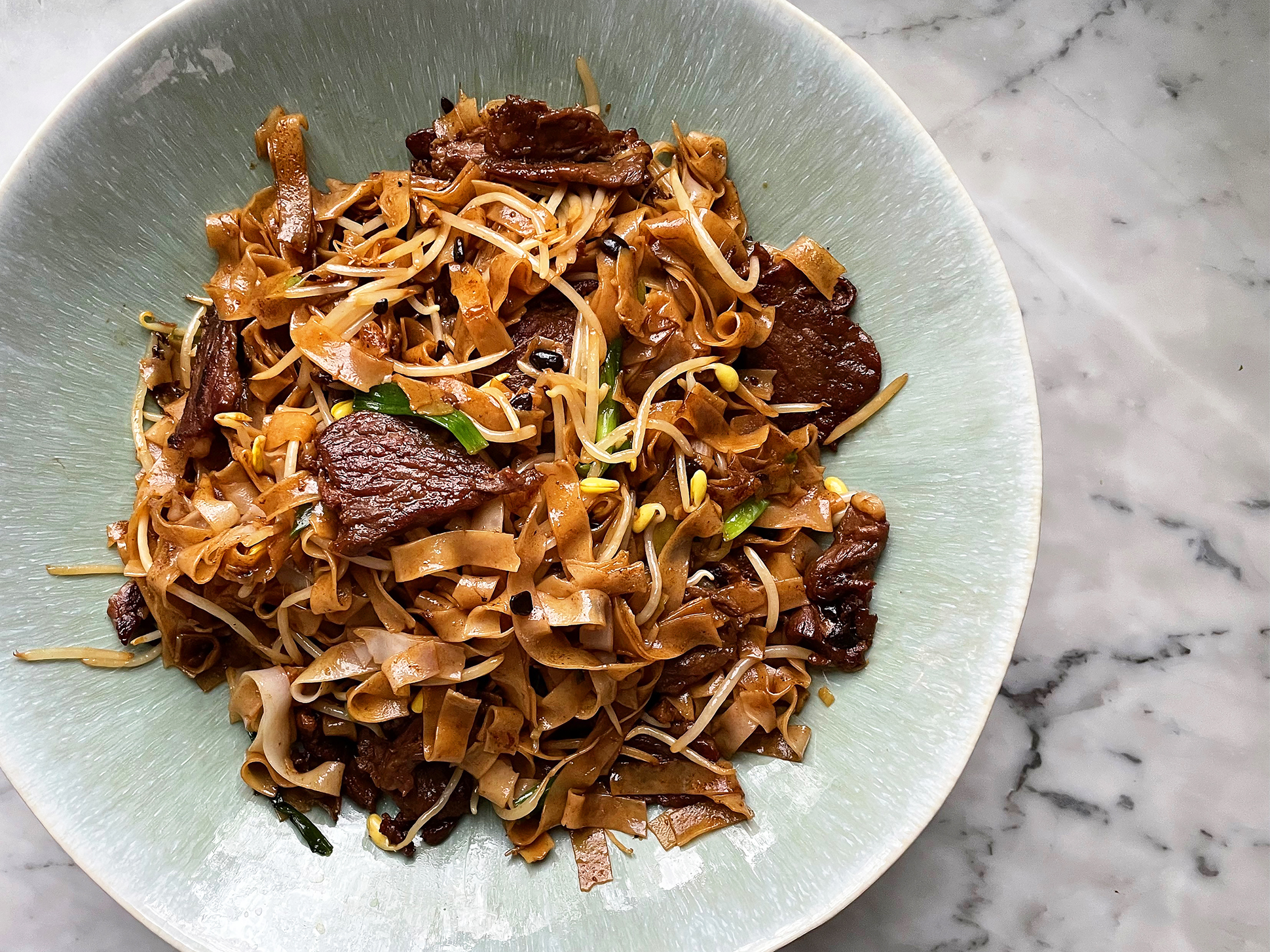Imagine a plate piled high with long, glossy noodles, tangled together with a savory medley of vegetables and tender protein.
This mouthwatering masterpiece is none other than chow fun, a beloved Cantonese dish that will transport your taste buds straight to the bustling streets of Guangzhou, China.
But what exactly is chow fun?
Join us on a culinary journey as we unravel the secrets behind this delectable noodle delight.
Prepare to be amazed by the tantalizing flavors and the surprisingly healthy benefits of this iconic dish.
what is chow fun
Chow fun is a popular Cantonese dish originating from Shahe, China.
It is made with chewy rice noodles that are stir-fried with protein, vegetables, and bean sprouts.
There are two styles of chow fun: wet and dry.
Common ingredients include wide rice noodles, protein, and vegetables.
The dish has a saucy consistency and is made with soy sauce, oyster sauce, sesame oil, ginger, garlic, and black pepper.
Chow fun is known for its balanced sweet, savory, and umami flavors.
It requires a large wok for cooking and involves several steps such as soaking the noodles, pan-frying the protein, adding vegetables and sauce, and frying the noodles.
Chow fun and chow mein are similar noodle dishes, but they differ in the type of noodles, amount of sauce, texture, and regional origins.
In terms of health, chow fun is considered healthier than chow mein due to its lower calorie and sodium content.
However, both dishes can be made healthier by reducing oil and high-sodium ingredients and adding fresh vegetables and lean protein.
Key Points:
- Chow fun is a popular Cantonese dish with chewy rice noodles, protein, vegetables, and bean sprouts.
- There are two styles of chow fun: wet and dry.
- Ingredients commonly used in chow fun are wide rice noodles, protein, and vegetables.
- The dish has a saucy consistency made with soy sauce, oyster sauce, sesame oil, ginger, garlic, and black pepper.
- Chow fun is balanced with sweet, savory, and umami flavors.
- It requires a large wok for cooking and involves several steps such as soaking noodles, pan-frying protein, adding sauce and vegetables, and frying the noodles.
what is chow fun – Watch Video
💡
Pro Tips:
1. Chow Fun is a popular Chinese dish that originated in the Guangdong province, known for its rich culinary history.
2. The name “Chow Fun” actually translates to “stir-fried rice noodles” in English, reflecting the primary ingredients used in the dish.
3. Despite being a Chinese dish, Chow Fun has gained immense popularity in Southeast Asian countries like Thailand, Malaysia, and Singapore, where it is a staple street food.
4. In traditional preparation, the wide rice noodles used in Chow Fun are stir-fried in a searingly hot wok, yielding a pleasantly smoky flavor and slightly charred edges.
5. While Chow Fun traditionally incorporates savory ingredients like beef, chicken, shrimp, and vegetables, there are also vegetarian versions available, typically featuring tofu or seitan as a protein substitute.
1. Origin Of Chow Fun In Guangzhou, China
Chow fun is a beloved Cantonese dish that traces its roots back to Guangzhou, China. Specifically, it originated in Shahe, a subdistrict of Guangzhou located in the southern part of the country. Guangzhou has been renowned for its diverse and mouthwatering dishes for centuries, and chow fun is no exception. This dish features chewy rice noodles, protein, vegetables, and bean sprouts, creating a flavorful combination that has captivated the taste buds of many across the globe.
2. Wet Vs Dry Chow Fun: A Flavorful Distinction
When it comes to chow fun, there are two distinct styles: wet and dry.
Dry chow fun features noodles with minimal sauce and seasoning, allowing the flavors of the other ingredients to shine through.
On the other hand, wet chow fun is characterized by a luscious gravy-like sauce that coats the noodles, vegetables, and protein, creating a delightful harmony of flavors in each bite.
The choice between wet and dry chow fun depends on personal preference and the specific culinary experience one wishes to savor.
- Dry chow fun: minimal sauce and seasoning, allowing flavors to shine through
- Wet chow fun: luscious gravy-like sauce that coats noodles, vegetables, and protein
“The choice between wet and dry chow fun depends on personal preference and the specific culinary experience one wishes to savor.”
3. Wide Rice Noodles And Delicious Additions
At the heart of chow fun are wide rice noodles, which are thick, chewy, and impart a delightful texture to the dish. These noodles serve as the perfect canvas for showcasing an array of delicious additions. Common proteins found in chow fun include beef, chicken, pork, shrimp, eggs, or tofu, providing a variety of options for every palate. When it comes to vegetables, popular choices include bean sprouts, bok choy, onions, mushrooms, and more. The combination of these elements creates a wholesome and satisfying dish.
- Wide rice noodles are the main ingredient in chow fun.
- These noodles have a thick, chewy texture.
- Chow fun offers a variety of protein options such as beef, chicken, pork, shrimp, eggs, and tofu.
- Vegetables like bean sprouts, bok choy, onions, and mushrooms are commonly included in chow fun.
- The combination of these ingredients results in a wholesome and satisfying dish.
4. Saucy Perfection: A Dive Into Chow Fun
Chow fun is renowned for its delectable sauce that brings the dish to life. The sauce is typically made with a blend of soy sauce, oyster sauce, sesame oil, ginger, garlic, black pepper, and sometimes sugar and starch to add sweetness and thickness. This intricate combination creates a rich and savory flavor profile that complements the other ingredients. The sauce envelops the noodles, protein, and vegetables, ensuring that each bite is infused with a burst of umami goodness and a subtle undertone of rice flavor.
5. Ingredients And Essential Components Of The Chow Fun Sauce
To truly appreciate the complexity of flavors in chow fun, it is important to explore the essential components of its signature sauce. The use of soy sauce adds a savory and salty note, while oyster sauce contributes a unique depth of flavor. The addition of sesame oil lends a nutty aroma, and the hint of ginger and garlic infuses the dish with a tantalizing warmth. Black pepper adds a subtle kick, and sugar and starch create a harmonious balance of sweetness and thickness. When these ingredients come together, they create a symphony of flavors that make chow fun an irresistible dish.
- Soy sauce: adds a savory and salty note
- Oyster sauce: contributes a unique depth of flavor
- Sesame oil: lends a nutty aroma
- Ginger and garlic: infuse the dish with a tantalizing warmth
- Black pepper: adds a subtle kick
- Sugar and starch: create a harmonious balance of sweetness and thickness
“When these ingredients come together, they create a symphony of flavors that make chow fun an irresistible dish.”
6. Balancing Flavors: A Symphony On Your Palate
One of the remarkable aspects of chow fun is its ability to achieve a perfect balance of sweet, savory, and umami flavors. While the sauce provides the foundation of these flavors, the combination of proteins, vegetables, and rice noodles adds depth and complexity. Each ingredient contributes its unique taste, texture, and aroma, coming together to create a harmonious symphony on your palate. The result is a dish that tantalizes the taste buds and leaves you craving for more.
- Chow fun achieves a perfect balance of sweet, savory, and umami flavors.
- The sauce is the foundation of these flavors.
- Combination of proteins, vegetables, and rice noodles adds depth and complexity.
- Each ingredient provides unique taste, texture, and aroma.
- Creates a harmonious symphony on your palate.
- Leaves you craving for more.
7. The Art Of Cooking Chow Fun: From Soaking To Stir-Frying
Preparing chow fun requires a certain level of skill and technique. The process begins with soaking the rice noodles to ensure they achieve the perfect chewy texture. Next, the protein is pan-fried to impart a delicious caramelized flavor. Then, the vegetables are added, providing freshness and vibrant colors to the dish. Finally, the sauce is introduced to the wok, coating all the ingredients in its luscious goodness. A brief stir-fry brings everything together, allowing the flavors to meld and the noodles to absorb the delectable sauce. The result is a plate of chow fun that is beautifully cooked and bursting with flavor.
8. Exploring Variations: Customizing Your Chow Fun
While the traditional chow fun recipe is undeniably satisfying, there is endless room for customization. Chefs and home cooks alike have adapted the dish to their preferences, incorporating different proteins and vegetables. Some variations may feature succulent slices of charred BBQ pork, others may highlight plump shrimp, and there are even vegetarian renditions with tofu and an assortment of colorful vegetables. The possibilities are truly limitless, allowing individuals to tailor the dish to their own tastes and dietary preferences.
9. Chow Fun Vs Chow Mein: Unraveling The Differences
Chow fun and chow mein are frequently talked about together in relation to Chinese noodle dishes. Despite their similarities, there are notable differences that distinguish them. The key contrast lies in the type of noodles employed. Chow fun utilizes wide rice noodles, while chow mein is typically made with thin wheat noodles. Furthermore, chow fun usually has less sauce and a chewier texture, whereas chow mein is more saucy and has a softer noodle consistency. These nuances, coupled with their regional origins, contribute to the distinct identity of each dish.
- Chow fun uses wide rice noodles
- Chow mein uses thin wheat noodles
- Chow fun has a chewier texture
- Chow mein has a softer noodle consistency
“The primary distinction lies in the type of noodles used.”
10. Chow Fun: A Healthier Twist On Chinese Noodles
Chow Fun: A Healthier and Delicious Cantonese Dish
For those looking for a healthier option among Chinese noodle dishes, chow fun stands out as an excellent choice. Compared to chow mein, chow fun is generally lower in calories and sodium, making it a healthier alternative. However, it’s important to note that the healthiness of these dishes can vary depending on the ingredients and cooking methods used.
To make chow fun or chow mein even healthier, consider the following tips:
- Reduce the amount of oil and high-sodium sauce ingredients to minimize added fats and sodium intake.
- Incorporate an abundance of fresh vegetables to increase the nutritional value of the dish.
- Choose lean protein sources, such as skinless chicken breast or tofu, to keep the dish light and protein-packed.
By following these modifications, you can ensure a wholesome and delicious meal that satisfies both your taste buds and your health goals.
“The healthiness of chow fun and chow mein can be improved by reducing the amount of oil and high-sodium sauce ingredients, incorporating an abundance of fresh vegetables, and choosing lean protein sources.”
In conclusion, chow fun is a beloved Cantonese dish that has gained popularity worldwide, thanks to its origins in Guangzhou, China. With its distinctive wet and dry styles, wide rice noodles, rich sauce, and a balance of flavors, chow fun offers a delightful dining experience. The art of cooking chow fun, along with its numerous variations and its differences from chow mein, adds to its allure. Whether enjoyed as a healthier twist on Chinese noodles or an indulgent treat, chow fun is sure to leave a lasting impression and satisfy even the most discerning palates.
💡
You may need to know these questions about what is chow fun
What is usually in chow fun?
Chow fun typically consists of deliciously stir-fried wide rice noodles known as he fen or huo fun, accompanied by tender beef, scallions, ginger, bean sprouts, and a generous drizzle of savory dark soy sauce. It’s a Cantonese specialty, commonly found in dim sum restaurants and Cantonese roast meat establishments, where the combination of flavors and textures creates a tantalizing dish that never fails to please the senses.
What is difference between chow mein and chow fun?
Chow mein and chow fun, two popular Chinese dishes, have distinct differences in their noodle and sauce preparation. Chow fun features wide and chewy rice noodles, whereas chow mein consists of thin and round egg noodles that develop a slight crispiness when cooked. Additionally, chow fun can be served with a wet or dry sauce, while chow mein tends to be slightly drier in comparison. Thus, the choice between these two dishes ultimately depends on one’s preference for noodle texture and sauciness.
What does chow fun taste like?
Chow fun, with its flat rice noodles, offers a unique taste experience compared to chow mein. The smooth, mild sweetness derived from the refined rice gives chow fun a distinctive flavor. The noodles themselves have a delicate texture that resembles pounded rice cakes or sticky rice. While chow mein leans more towards pasta-like flavors, chow fun brings forth its own delightful rice-like essence.
What is the difference between mei fun and chow fun?
Mei fun and chow fun may share their Chinese roots, but they diverge when it comes to their noodle thickness. While chow fun boasts wide and thick noodles, mei fun takes on a more delicate form, reminiscent of vermicelli. This disparity in texture determines their contrasting culinary applications. Chow fun’s substantial nature makes it a remarkable choice for stir-fries, where its heartiness can stand up to the robust flavors. In contrast, mei fun’s thin strands excel in soups and salads, where their delicacy can effortlessly absorb the nuanced flavors of the accompanying ingredients.
Reference source
https://thewoksoflife.com/beef-chow-fun-noodles/
https://drizzlemeskinny.com/chow-fun-vs-chow-mein-comparing-two-chinese-noodle-dishes/
https://www.honestfoodtalks.com/chow-fun-vs-chow-mein/
https://drizzlemeskinny.com/chow-fun-vs-mei-fun-unraveling-the-differences-between-two-classic-chinese-rice-noodles/



